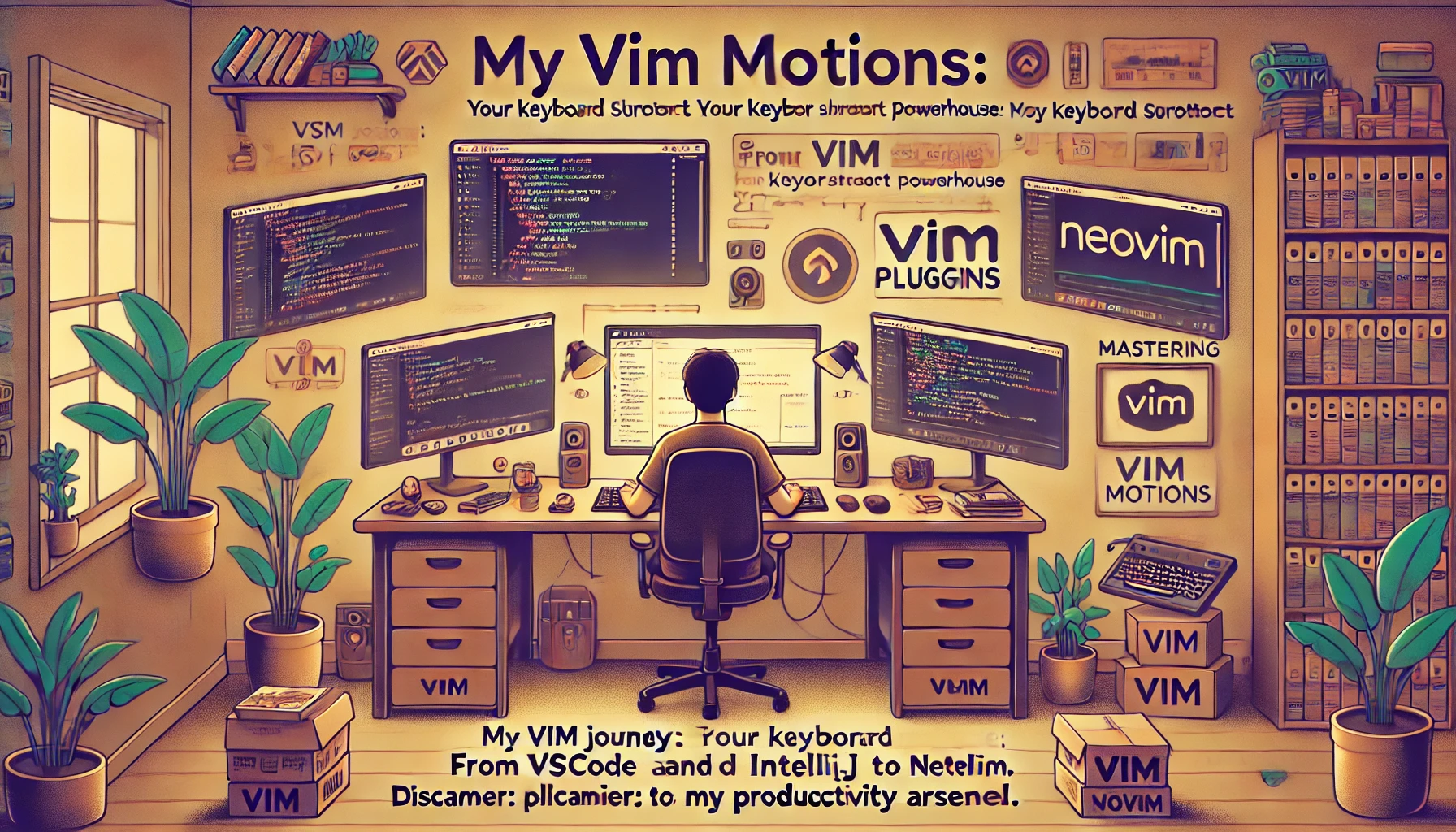Vim Motions: Navigating and Editing Code Efficiently
Vim Motions: Your Keyboard Shortcut Powerhouse
Vim motions are a set of commands that empower you to navigate and edit code like a pro. This guide dives into different Vim motions and how to harness them for lightning-fast coding.
My Vim Journey: From VSCode and IntelliJ to Neovim and AstroVim
After years of using VSCode and IntelliJ, I decided to make the switch to Neovim as my primary development tool. Neovim is a hyperextensible Vim-based text editor that provides a modern and more powerful experience compared to traditional Vim. Recently, I transitioned to AstroVim, a Neovim configuration that comes with a set of built-in plugins and features that enhance productivity.
AstroVim offers an intuitive file explorer, search functionality, and other built-in plugins that make the development experience smoother and more efficient. The decision to switch was driven by the need for a more integrated and user-friendly environment, which AstroVim provides out of the box.
This series of posts will document my journey and share the tips, tricks, and configurations that have made Neovim and AstroVim indispensable parts of my workflow.
After years of using VSCode and IntelliJ, I decided to make the switch to Neovim as my primary development tool. This series of posts will document my journey and share the tips, tricks, and configurations that have made Neovim an indispensable part of my workflow.
Today, we’re starting with the foundation: Vim motions. Mastering these commands is key to unlocking the full potential of Vim’s editing power.
Disclaimer: This is not meant to be a flamewar about editors. It’s simply a reflection of what has worked best for me and an invitation for you to explore if Vim might be a good fit for your own development style.
Vim Plugins: My Productivity Arsenal
AstroVim comes with a curated set of plugins that enhance the Neovim experience. Here are some of the default plugins included in AstroVim:
- “nvim-treesitter” - Syntax highlighting and code navigation
- “telescope.nvim” - Fuzzy finder and file explorer
- “nvim-lspconfig” - Language Server Protocol configurations
- “nvim-cmp” - Autocompletion plugin
- “gitsigns.nvim” - Git integration
- “lualine.nvim” - Status line
- “which-key.nvim” - Keybinding helper
- “nvim-tree.lua” - File explorer
- “bufferline.nvim” - Buffer line for managing open files
- “plenary.nvim” - Lua functions used by many plugins
- “copilot.vim” - AI-powered code completion
- “catppuccin/nvim” - Catppuccin Macchiato theme for Neovim
(Complete plugin setup and details will be covered in future posts.)
The Vim Editor: More Than Meets the Eye
Vim is a highly customizable text editor known for its modal nature. Its modes – Normal, Insert, and Visual – cater to distinct tasks, allowing you to switch seamlessly between command input and text editing.
Vim Plugins: Supercharge Your Vim Experience
Vim’s capabilities extend far beyond its core features. With a vast array of community-maintained plugins, you can transform Vim into a full-fledged Integrated Development Environment (IDE).
Vim Motions in Action
By mastering Vim motions, you’ll write and navigate code with impressive speed. Even popular IDEs like VS Code offer Vim plugins, enabling you to leverage Vim’s navigation within your preferred environment.
Vim Modes:
- Normal Mode: Your command center for issuing instructions.
- Insert Mode: Where the actual code writing happens.
- Visual Mode: Select and manipulate text visually, with options for both normal and block selection.
Vim also has a leader key for creating custom shortcuts, and a command mode for operations like saving files.
Navigating Your Codebase
AstroVim enhances navigation with additional keybindings that streamline your workflow:
Window Navigation (Ctrl + h/j/k/l): Quickly move between split windows using
Ctrlcombined withh,j,k, orl.Buffer Navigation (]b, [b): Use
]bto move to the next buffer and[bto move to the previous buffer, making it easy to switch between open files.Resize Windows (Ctrl + Arrow Keys): Adjust window sizes with
Ctrland the arrow keys for up, down, left, and right.Toggle Neotree (Leader + e): Open or close the file explorer with
Leader + efor quick access to your project files.Toggle Comment (Leader + /): Comment or uncomment lines with
Leader + /, streamlining code documentation and debugging.Open Terminal (Leader + tf): Launch a floating terminal with
Leader + tffor quick command-line access without leaving Neovim.
Let’s dive into a React app and explore how Vim motions streamline navigation:
Basic Movements (h, j, k, l): Forget arrow keys! Use these for left, down, up, and right movement. Prefix with a number (e.g.,
5j) to move multiple lines.Word Navigation (w, b, e): Jump forward (
w), backward (b), or to the end (e) of words. Use a number prefix for multiple word jumps.Line Navigation (0, ^, g, $, f, F): Go to the start (
0), first non-blank character (^), end ($), or search for a character (fforward,Fbackward).Vertical Navigation ((), {}, Ctrl+D/U, Ctrl+F/B, G): Navigate by sentences (
(and)), paragraphs ({and}), half pages (Ctrl+D,Ctrl+U), full pages (Ctrl+F,Ctrl+B), start of file (gg), and end of file (G).
Entering Insert Mode: Multiple Entry Points
Vim offers various ways to enter insert mode, each suited for different editing scenarios:
Before cursor (
i): Use this when you need to insert text right before the current cursor position. For example, adding a missing character in a variable name.After cursor (
a): Ideal for appending text immediately after the cursor. This is useful when you want to add a semicolon at the end of a statement.Beginning of line (
I): Quickly jump to the start of a line to insert text. This is handy for adding comments or annotations at the start of a line of code.End of line (
A): Move to the end of a line to append text. Use this when you need to extend a line with additional code or comments.Below current line (
o): Open a new line below the current one and enter insert mode. This is perfect for adding a new line of code in a block.Above current line (
O): Similar too, but opens a new line above. Use this when you need to insert a line before the current one, such as adding a new function definition.
Other insert mode triggers include c (change), s (substitute), y (yank/copy), and p (paste). You can even copy entire lines with yy.
Learning More
Vim’s learning curve can be steep, but the rewards are immense. To deepen your knowledge:
- Vim Documentation: https://vimdoc.sourceforge.io/index.html
- Vim Tutorial: https://www.tutorialspoint.com/vim/vim_tutorial.htm
- Vim Cheat Sheet: https://www.vim.org/doc/vimtutor/vimtutor.pdf
Happy Vimming!


